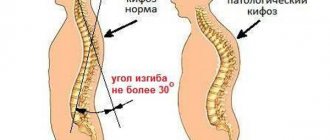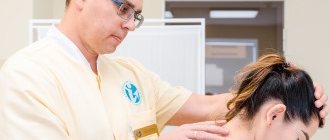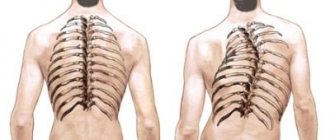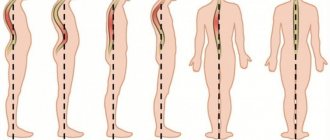Cervical kyphosis is a rare phenomenon. It is characterized by the formation of curvature in the backward direction. The reasons for the appearance and development of cervical kyphosis can be very different: from injuries to infectious diseases. Regardless of them and the degree of development of the pathology, it can cause serious health problems.
You can undergo a course of treatment for cervical kyphosis at the CELT multidisciplinary clinic. Our doctors have everything necessary to correctly diagnose and prescribe treatment for this disease, which is sure to give positive results.
What kind of disease is this
Kyphosis of the cervical spine is a condition in which the natural deflection of the neck begins to straighten . Physiological kyphosis is normally observed in the thoracic and sacral regions. Small deflections are necessary to provide shock absorption to the skeleton.
With cervical kyphosis, lordosis in this area begins to straighten
Pathology of the cervical spine can appear in patients of all ages, even in infants. Kyphosis develops due to the fact that the spine cannot maintain the correct shape. This happens due to weakened muscles that support the spinal column and increased bone fragility.
Brief history of the disease
Kyphosis of the cervical spine develops almost imperceptibly . Patients cannot identify it on their own. But as the disease progresses, it provokes the appearance of a number of unpleasant symptoms. Many people do not pay attention to the emerging signs of the disease and ignore them. This leads to a deterioration in the patient's condition.
Classification of pathology
Experts distinguish 3 stages of kyphosis of the cervical spine . They depend on the degree of curvature:
| minimum | curvature angle less than 30o |
| average | angle 30-60o |
| heavy | angle more than 60o |
Kyphosis is also classified depending on the cause of its occurrence . He can be:
| degenerative-dystrophic | the processes of biochemical metabolism in tissues are disrupted and the blood supply to the spine deteriorates |
| rachitic | occurs due to vitamin D deficiency |
| paralytic | with brain lesions, muscle contractile functions are sometimes impaired; this form of kyphosis is often found in children with cerebral palsy |
| infectious | vertebrae may become deformed due to spondylitis or tuberculosis |
| senile | occurs due to spinal involution in old age |
Doctors include senile kyphosis in the general concept of “senile back” . Also, depending on the time of onset of the disease, congenital and acquired kyphosis are distinguished.
Prevalence and significance
Kyphosis of the upper spine occurs in almost 8-10% of the entire population .
But for many it is weakly expressed. Kyphosis of the cervical spine is a fairly rare pathology. But the seriousness of this problem cannot be underestimated. It leads to disruption of blood supply to the brain.
Pathogenesis
Each type of kyphosis has its own pathogenesis, but the manifestations are the same - a change in the anatomical structure of the cervical spine, which can harm overall health.
All vertebrae are connected to each other using intervertebral discs - a kind of cartilage pad to absorb physical stress, ligaments of elastic tissue and tendons for attaching muscles to the bones that hold the spinal column.
Under unfavorable conditions, the spinal ligaments are stretched, the muscles weaken, and cease to perform their function, allowing the vertebrae to take on other shapes and bend.
Risk factors, causes and consequences
All causes of kyphosis are conventionally divided into congenital and acquired . The main risk factor for the appearance of deformity is genetic predisposition. If several generations in the family have had kyphosis, then with a high degree of probability it can be assumed that the genes that are responsible for abnormalities in the development of the spine will be passed on to the child.
With rickets in childhood, the likelihood of developing kyphosis increases. It usually occurs in the first year of life. Experts classify such kyphosis as congenital. In some children, kyphosis appears during fetal development or as a result of birth injuries.
Acquired causes of cervical kyphosis include:
- various diseases of the spine (spondylosis, osteoporosis, osteochondrosis);
- age-related changes that provoke changes in the structure of the vertebrae and intervertebral discs;
- spinal injuries, damage to ligaments and back muscles;
- insufficient physical activity, excessive exercise;
- incorrect posture (scoliosis);
- inflammatory and infectious diseases that provoke the appearance of problems with the spine (for example, with tuberculosis, the structure of the vertebrae themselves changes);
- tumors (benign and malignant) that are in contact with the spine;
- herniated intervertebral discs.
Also, kyphosis of the cervical spine can be one of the manifestations of Scheuermann-Mau disease. It develops mainly in young men during adolescence.
Scheuermann-Mau disease is a common cause of cervical kyphosis.
In the absence of treatment or its ineffectiveness, pinching of the spinal cord roots may begin . This leads to disturbances in the functioning of the respiratory and cardiac organs. Patients with cervical kyphosis suffer from frequent pneumonia and bronchitis. Even at rest they experience shortness of breath. But this is not the only negative consequence of kyphosis. Patients also begin to experience arrhythmia and problems with blood pressure.
Symptoms and diagnostic methods
It is almost impossible to independently identify kyphosis in the early stages. Therefore, patients need to know what signs of progression of this disease exist. When the first symptoms appear, you should consult your doctor. He will conduct a diagnosis and, if cervical kyphosis is confirmed, prescribe appropriate treatment.
Symptoms of cervical kyphosis include:
- the appearance of headaches;
- numbness of the limbs;
- development of hypertension or, conversely, hypotension;
- slouch;
- tingling sensation in the lower jaw;
- deterioration of vision and hearing;
- weakness, fatigue.
Doctors divide all signs of kyphosis into 2 groups : vertebral; extravertebral.
The first group includes impaired neck mobility and the appearance of a crunching sound when turning the head.
The second group includes weakness of the eye muscles and decreased skin sensitivity. If the nerve roots are excessively compressed, the condition may worsen. Peripheral and central paralysis occurs, some even experience urinary disorders.
After interviewing the patient and clarifying the main symptoms, the doctor prescribes an x-ray of the cervical spine in two projections. This study allows you to identify the curvature and determine the degree of kyphosis. You can check whether blood vessels and nerve endings are pinched using MRI and CT.
If kyphosis is confirmed, then it is necessary to evaluate the condition of the internal organs that most often suffer from kyphosis: the lungs and heart.
Contraindications
All types of treatment should be prescribed only by a doctor. Self-medication is not acceptable! Some methods have certain contraindications. For example, massage is not prescribed for acute infections, febrile conditions, tumors, tuberculosis, trophic skin ulcers and purulent processes. Exercise therapy also has limitations, such as infectious pathologies, problems with mental state, temperature above 37.5 degrees, high blood pressure, ARVI and diseases associated with poor blood clotting. Manual therapy is contraindicated for tumors of the spinal column, brain and spinal cord and any internal organs of any quality, acute inflammatory processes in the joints, the postoperative period, ankylosing spondylitis, strokes, heart attacks and other diseases associated with blood circulation and the brain, and acute forms of osteomyelitis and tuberculosis.
Treatment
Did you know that...
Next fact
It is quite difficult to get rid of the appearance of pathological curvature in the cervical spine. The treatment process is long, but good results can be obtained by following all the recommendations of the attending physician. In the early stages, only conservative methods of therapy are used, but if the condition worsens, surgical treatment is possible.
Therapy should be aimed at stopping the deformation process and eliminating the curvature, reducing the degree of pressure on the nerve endings, and protecting the spinal substance from possible damage.
Drugs used
For prevention and better absorption of calcium in kyphosis, preparations with vitamin D are used. For the treatment of cervical kyphosis, drug therapy is prescribed.
Depending on the condition, the doctor recommends using:
- products containing calcium;
- vitamin D;
- anti-inflammatory medications;
- antidepressants (they are necessary to improve the patient’s nervous condition);
- drugs that relax muscle spasms.
If possible, therapy is carried out aimed at eliminating the causes that provoked the appearance of kyphosis.
Surgery
Surgeries for kyphosis of the cervical spine are prescribed in cases where conservative treatment is ineffective. Surgery is also recommended in cases where the patient consults a doctor too late.
Among the main indications are:
- curvature over 75o;
- persistent pain that cannot be controlled with medication;
- disturbance of blood circulation and breathing.
To correct kyphosis, special systems consisting of rods and screws are installed . The surgeon must reliably stabilize the position of the vertebrae to prevent future progression of the disease. Such systems can only be installed after the growth period has ended.
Exercises and massage
Daily regular performance of therapeutic exercises is the main method of treating kyphosis . Proper execution of exercises allows you to strengthen the ligamentous-muscular system. This helps improve lymph and blood circulation, increase flexibility of muscles and joints, and eliminate pain. Swimming in the pool will also be useful. It helps to relax the desired muscle groups.
A set of exercises for cervical kyphosis is selected individually for each patient. The doctor takes into account the patient’s condition, the causes of kyphosis and the strength of the deformation. When performing exercises, the patient must monitor his posture.
Gymnastics is aimed at strengthening the neck muscles. Various neck stretches, turns, and bends are actively used. Gymnastics must be performed daily for 10-15 minutes .
Therapeutic massage has its advantages in the treatment of neck kyphosis. Massage will be effective with minimal and medium degrees of curvature. The doctor acts on problem areas of the spine and surrounding tissues.
Thanks to high-quality massage, this result can be achieved.:
- intervertebral discs, vertebrae, joints take the correct position;
- pain in the back and neck disappears;
- blood circulation improves;
- the muscle corset is strengthened;
- muscle tension is minimized.
Typically, manual therapy sessions for cervical kyphosis are performed every other day. The tactics of the massage and its duration are determined by the doctor individually, depending on the patient’s condition and the degree of deformation.
Video: “Exercises to strengthen the neck”
Treatment at home
The main treatment to correct kyphosis should be done at home. In addition to daily gymnastics and the use of special medications, people are recommended to wear orthopedic corsets . With their help, children can correct curvature. The use of a corset by adult patients helps stop the deformation.
Therapeutic measures
Kyphosis cannot be cured. Deformation changes due to degeneration of vertebral tissue are irreversible. In childhood, when ossification has not yet occurred, kyphosis is “leveled” using corrective methods. In an adult, it is only possible to stop the process and alleviate the condition with symptomatic treatment.
Complex treatment includes the use of medications, physiotherapy procedures, massage, and physical therapy. If left untreated or treated incorrectly, the curvature can lead to a critical condition for the patient.
Pharmacotherapy
The goal of drug therapy for cervical kyphosis is to eliminate unpleasant symptoms that negatively affect the patient’s quality of life. To relieve pain, the doctor prescribes nonsteroidal anti-inflammatory drugs (Ketorolac, Ketoprofen, Diclofenac), which simultaneously prevent inflammatory processes. For headaches, antispasmodics are used - Spazgan, Spazmalgon, Bral.
Muscle relaxants (Mydocalm, Sirdalud) will ensure relaxation of muscle fibers, relieving their spasm. Chondroprotectors (Teraflex, Honda, Arthra) will help stop degenerative processes in tissues and create conditions for cell self-healing. Long-term use of drugs in this group will stop degenerative processes in the tissues of the spine.
Nootropic drugs (Phenibut, Tenoten, Piracetam) improve the functioning of the nervous system and partially relieve neurological symptoms. To improve cerebral circulation, Vinpocetine, Memoplant, Tanakan are prescribed, which will relieve dizziness and normalize the general condition.
Physiotherapy
Kyphosis of the cervical spine rearranges the work of the tissues, muscles, and vessels surrounding the affected area, metamorphoses with which lead to the appearance of general symptoms. Modern methods of physiotherapy improve blood circulation, increasing the lumen of blood vessels, and improve the functioning of muscle tissue and the nervous system.
Physiotherapeutic procedures:
- electrophoresis can be prescribed with painkillers (Novocaine, Lidocaine), as well as with steroid hormones (Prednisolone, Hydrocortisone), if the deformity is accompanied by inflammatory reactions;
- exposure to laser beams;
- magnetic therapy using Almag-03, which is specially designed for the treatment of cerebrovascular accidents;
- ultrasound therapy.
Orthopedic products
It will not be possible to correct kyphosis using specially designed medical products, but orthopedic devices are effective in unloading the affected area of the spine and improving the functioning of muscles and blood vessels.
To create a gentle regime, a medium-hard Shants collar is assigned to the vertebrae. In order for the device to bring maximum effect, it is necessary to choose the correct collar height. The size is determined individually by measuring the distance from the chin to the jugular fossa, with the head positioned level.
An orthopedic pillow is selected for sleeping, which prevents circulatory disorders at night. For a “correct” pillow, the height of the bolster should correspond to the height of the person’s shoulder girdle. To increase the distance between the vertebrae during rest, it is recommended to sleep on an orthopedic mattress.
Prevention of kyphosis
It is quite possible to prevent the occurrence of curvature of the cervical spine . To do this you need:
- constantly monitor your posture and neck position;
- monitor your physical fitness: regular physical activity helps strengthen the muscle frame;
- If visual acuity is reduced, use glasses or contact lenses.
When the first symptoms of kyphosis appear, you should consult a doctor. Curvature can be corrected in the initial stages of the disease even in adulthood.
Forecast
If left untreated, kyphosis will progress . This provokes a deterioration in blood supply to the brain. As a result, the patient experiences severe pain. They are localized mainly in the occipital part. In addition, problems arise with the functioning of the respiratory and cardiovascular systems.
When kyphosis is detected in childhood, it is possible to get rid of the disease using a conservative method in more than 90% of cases. In patients over 16 years of age, it is much more difficult to remove the deformity. Treatment is aimed at stopping the progression of the disease.
Diagnostic features
Experienced orthopedic doctor
pathological kyphosis will be seen when examining the patient.
The patient is identified by a hunched back, drooping shoulders, protruding forward. The specialist conducts tests, studies medical history, and evaluates appearance. To make an accurate diagnosis, it is necessary to determine the degree of development of the disease. To determine the angle of inclination and the severity of the pathology, radiography
in different projections (lateral and direct).
The picture is clarified using computer
and
magnetic resonance imaging
.










